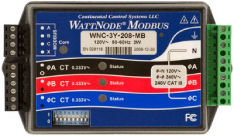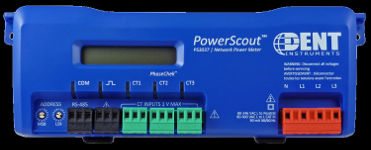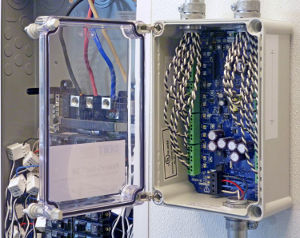Electrical Meters – Modbus RTU and Pulse Output
Logic Beach offers two families of electrical meter transducers that readily interface to our data logging instruments. Depending on the model, the meter to data logger interface can be Modbus RTU and/or a simple Pulse output.
PowerScout: The PowerScout line of meters offers both Modbus RTU and Pulse outputs in a single unit.
Wattnode: The Wattnode line offers the WNC Modbus only output meters and the WNB Pulse only output meters. Specifics on Modbus RTU interface vs Pulse interface follow.
Modbus RTU Interface
For applications requiring detailed electrical power information with multiple electrical parameters, Logic Beach offers Modbus RTU enabled electrical parameter meters. These meters can measure electrical loads and provide multiple electrical parameters via a Modbus RTU interface including power (kW), energy (kWh), phase voltages, phase currents, power factor and much more.
The IntelliLogger family of data loggers configured as a Modbus RTU Master can interrogate and log user specified parameters from one or more connected Modbus RTU Slave power meters. Simultaneous with the readings logged via the Modbus interface, the IntelliLogger can be sampling, processing, logging and reporting hard-wired inputs (e.g. thermocouples, pressures, flows, etc) as well.
The Modbus RTU interface uses a two-wire serial RS-485 connection between the IntelliLogger and the meters. Each device (meter or other Modbus Slave device on the RS-485 network) is assigned a unique device address allowing up to 15 Modbus devices to be connected to a single IntelliLogger.
Details on the various Modbus connected multi-parameter meters follow. Additional details on Modbus and the Modbus option for the IntelliLogger data logging instrument family are available on the IntelliLogger Modbus Interface Options page.
Pulse Output Interface
For applications requiring only energy logging (kWh), electrical meters equipped with pulse outputs (instead of Modbus) can be utilized. Meters with pulse outputs output a switch closure “pulse” that corresponds to some unit of energy measured. By totalizing the pulses over a period of time (eg 15 minute utility intervals) and appropriate scaling within the Logic Beach logger, the energy usage can be profiled.
Additionally, Pulse Output meters can be used to garner instantaneous Power (demand) by measuring the frequency of the energy pulse output. Logic Beach data loggers can be readily programmed to perform the necessary calculations to determine instantaneous power from the Energy pulse output allowing two commonly desired electrical parameters to be logged from a single lower cost Pulse Output meter.
PowerScout – Universal Electrical Service with Modbus and Pulse Outputs Overview:
The PowerScout power meters are available in two major models… the PS3037 for single electrical service monitoring and the PowerScout 24 commonly used for sub-metering applications where up to 24 branch circuits can be monitored. The PowerScout line of meters is flexible in design in that a single model can be used on the full gamut of electrical service configurations (eg Wye and Delta) as well as a full range of service voltages from 80Vac to 600Vac.
PowerScout PS3037
The PowerScout 3037 is a revenue-grade, single-point 3-phase power meter that communicates with the Logic Beach data loggers via its Modbus RTU or Pulse output. The PowerScout Meter can monitor voltage, current, power, energy, and many other electrical parameters on single and three-phase systems. With the Modbus RTU interface option the IntelliLogger can be simply programmed to acquire readings from the PowerScout internal registers for use in the IntelliLogger Program Net. Users can simply select desired parameters to log.
All PowerScout 3037 models have a broadband power supply (80-600VAC) which allows them to operate on electrical services from 120Vac single phase to 480Vac 3phase. They can be paired with a variety of current transformers, from split cores that measure < 1A up to large RoCoils designed for measuring 4000A. In addition, communication protocols are field-selectable. Easily toggle between Modbus or BACnet using ViewPoint software.
The PowerScout 3037 is available with an optional LCD for viewing setup and real-time paraemters. Additiionally, it is available with RS-485 (for Modbus) and optionally Ethernet connectivity. All units have a pulse output that can be linked to various parameters (eg energy where each pulse corresponds to some user defined unit of energy).
The PowerScout can be used for temporary test applications such as energy audits or M&V studies or permanently installed for long term monitoirng, sub-metering, etc.
PowerScout 24
The PowerScout 24 is similar to the PS3037 but has the ability to record power on 24 sub-circuits that are sharing a single supply voltage. The PowerScout 24 can be used to monitor up to 24 single phase circuits or up to 8 three phase circuits… all in one instrument. Via a Modbus RTU connection to the IntelliLogger data logging instrument, registers within the PS24 are easily read and used in the IntelliLogger Program Net for data acquisition, sub-metering, alarming and reporting.
Wattnode – Lower Cost Specific Electrical Service Meters; Pulse or Modbus Output
The Wattnode family of Electrical Meters are available with Modbus RTU (WNC series) or Pulse (WNB series) Outputs. Specific models with the WNC and WNB familes are specified for different electrical service configurations.
WNC – Modbus (Multi-Parameter) Output
WNB – Pulse (Energy Only) Output
WNC Series Modbus Output Meter Overview
 The WNC-MB family of Modbus output Energy Meters are flexible in configuration and power level due to user interchangeable current transformers (CT’s) and the Modbus interface. Via the Modbus interface, the connected Modbus RTU Master device (e.g. the IntelliLogger data logging and alarming instrument from Logic Beach) can be programmed to read and log one or more desired electrical parameters from one or more connected meters.
The WNC-MB family of Modbus output Energy Meters are flexible in configuration and power level due to user interchangeable current transformers (CT’s) and the Modbus interface. Via the Modbus interface, the connected Modbus RTU Master device (e.g. the IntelliLogger data logging and alarming instrument from Logic Beach) can be programmed to read and log one or more desired electrical parameters from one or more connected meters.
The WNC-MB Energy Meters are available for various wiring configurations and voltages and can be used in single phase as well as poly-phase applications. Terminal strips are provided for CT and Voltage Sense wiring connections. A wide range of compatible CT’s are available.
In operation, the WNC-MB meter samples the current and voltage every second then calculates various electrical parameters (phase voltages, phase currents, power, power factor, etc). These parameters are written to Modbus registers (memory locations) within the meter. These registers are in turn read periodically by the connected Modbus RTU Master device.
Use of the WNC-MB meter with the Logic Beach IntelliLogger provides a powerful solution for R&D, performance testing, energy audits, M&V applications for utility rebates and other energy monitoring applications. With the IntelliLogger and WNC-MB system, data logging, local alarming, reporting via FTP and Email as well as Web page serving of current values is readily handled… all via the IntelliLogger and the powerful HyperWare-II icon-based programming software.
WNC Modbus RTU Output Meter General Specifications:
Measured Parameters:
- True RMS Power – Watts (Phase A, B, C and Sum)
- Reactive Power – VARs (Phase A, B, C and Sum)
- Power Factor – (Phase A, B, C and Average)
- True RMS Energy – Watthours (Phase A, B, C and Sum)
- Reactive Energy – VAR-hours (Sum)
- AC Frequency
- RMS Voltage (Phase A, B and C)
- RMS Current (Phase A, B and C)
- Demand and Peak Demand
Accuracy: Typical 1% Reading plus CT error (typically also 1%)
Frequency Measurement Range: 48-62 Hz
Line Voltages Supported: 120 to 600Vac (per model)
Current: 5% to 100% of rated current
Compatible Current Transformers: 333mVac output CT’s
Output: Modbus RTU, RS-485 2-wire, 9600 and 19,200 baud, N81
Price range: $300 to $400 plus split-core CT’s (~$50 to $80 each)
Electrical Service/Load Compatibility:
Refer to the following table to select the WNC model for the application electrical service or load configuration.
WNC – Modbus Enabled Wattnode Electrical Meter Selection Table
| Model | VAC Phase to Neutral | VAC Phase to Phase | Supports these Electrical Service Types | Neutral Required |
|---|---|---|---|---|
| WNC-3Y-208-MB | 120 | 208-240 | 1 Phase 2 Wire 120V with neutral 1 Phase 3 Wire 120V/240V 3 Phase 4 Wire Wye 120V/208V |
Yes |
| WNC-3Y-400-MB | 230 | 400 | 1 Phase 2 Wire 120V with neutral 3 Phase 4 Wire Wye 230V/400V |
Yes |
| WNC-3Y-480-MB | 277 | 480 | Single-Phase 277V with neutral | Yes |
| WNC-3Y-600-MB | 347 | 600 | Single_phase 347V with neutral | Yes |
| WNC-3D-240-MB (can be used for Delta or Wye wiring configurations) |
N/A | 208-240 | 1 Phase 2 Wire 208V (No Neutral) 1 Phase 2 Wire 240V (No Neutral) 1 Phase 3 Wire 120V/240V 3 Phase 3 Wire Delta 208-240V (No Neutral) 3 Phase 4 Wire Wye 120V/208V |
No |
| WNC-3D-400-MB (can be used for Delta or Wye wiring configurations) |
N/A | 400 | 3 Phase 3 Wire Delta 400V (No Neutral) 3 Phase 4 Wire Wye 230V/400V |
No |
| WNC-3D-480-MB | N/A | 400-480 | 3 Phase 3 Wire Delta 480V (No Neutral) 3 Phase 4 Wire Wye 277V/480V |
No |
WNB Series Pulse Output Meter Overview
For applications requiring only energy logging instead of detailed electrical parameters, the slightly lower cost WNB family of Wattnode meters with a Pulse output (instead of Modbus) can be used. The WNB series meter measures electrical energy and outputs a pulse corresponding to a scaled unit of energy (eg kWh). The pulse is then counted and totalized with a Logic Beach data logger digital “counter” input. The logger then scales the pulse count to units of energy and totalizes as desired by the user for the application (eg 15 minute utility intervals, daily totals, etc).
The WNB Energy Meter can also be used to measure instantaneous Demand (power in Watts) by measuring the output pulse frequency. If this feature is desired, it is common to order the unit with a higher full scale output frequency to improve measurement resolution (e.g. order with 300Hz Full Scale output). The standard unit is provided with a Full Scale output frequency of 4Hz. With this setting, when the meter is running at the maximum energy, 4 pulses per second will be output.
With the ‘P3’ option, a single Energy Meter can be used to measure 3 single phase branch circuits with one meter.
WNB Pulse Output Meter General Specifications:
Measured Parameters: True RMS Energy
Accuracy: 1% Rdg plus CT error (typically also 1%)
Frequency Measurement Range: 48-62 Hz
Line Voltages Supported: 120 to 600Vac (per model)
Current: 5% to 100% of rated current
Output: Opto-isolated switch
Full Scale Pulse Output Frequency: 4.00 Hz (optional frequencies up to 600Hz available).
Optional Multiple Pulse Outputs: ‘P3’ order option allows for 3 isolated pulse outputs from a single unit. When ‘P3″ Option is specified, the meter can be used for multi-branch (3) monitoring or per phase monitoring applications.
Price range: $225 plus split-core CT’s (~$50 to $80 each)
Electrical Service/Load Compatibility:
Refer to the table below to select the WNB model for the application electrical service or load configuration.
WNB – Pulse Output Wattnode Electrical Meter Selection Table
| Model | VAC Phase to Neutral | VAC Phase to Phase | Supports these Electrical Service Types | Neutral Required |
|---|---|---|---|---|
| WNB-3Y-208-P | 120 | 208-240 | 1 Phase 2 Wire 120V with neutral 1 Phase 3 Wire 120V/240V 3 Phase 4 Wire 120V/208V |
Yes |
| WNB-3Y-400-P | 230 | 400 | 1 Phase 2 Wire 230V with neutral 3 Phase 4 Wire Wye 230V/400V |
Yes |
| WNB-3Y-480-P | 277 | 480 | 1 Phase 277V with neutral | Yes |
| WNB-3Y-600-P | 347 | 600 | 1 Phase 347 with neutral | Yes |
| WNB-3D-240-P (can be used for Delta or Wye wiring configurations) |
N/A | 208-240 | 1 Phase 2 Wire 208V (No Neutral) 1 Phase 2 Wire 240V (No Neutral) 1 Phase 3 Wire 120V/240V 3 Phase 3 Wire Delta 208-240V (No Neutral) 3 Phase 4 Wire Wye 120V/208V |
No |
| WNB-3D-400-P (can be used for Delta or Wye wiring configurations) |
N/A | 400 | 3 Phase 3 Wire Delta 400V (No Neutral) 3 Phase 4 Wire Wye 230V/400V |
No |
| WNB-3D-480-P | N/A | 400-480 | 3 Phase 3 Wire Delta 480V (No Neutral) 3 Phase 4 Wire Wye 277V/480V |
No |
| WNB-Custom Freq Option |

